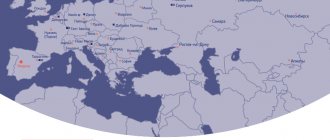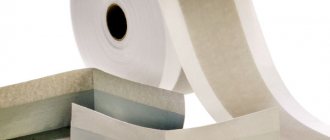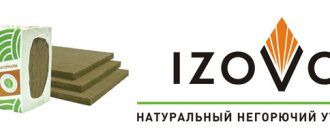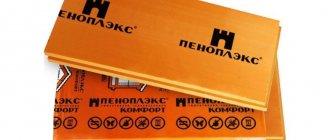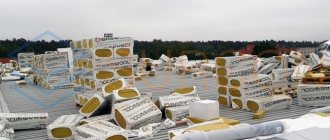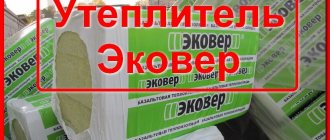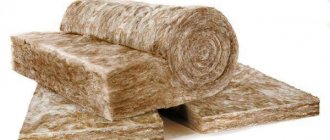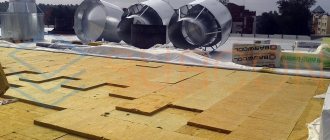The URSA company supplies various types of insulation materials to the Russian market, which are designed to provide thermal and sound insulation in multilayer structures of residential, non-residential and industrial buildings.
URSA insulation materials are suitable for all areas of application:
- external work under protective cladding;
- interior finishing for finishing coatings;
- roofing and foundation insulation;
- industrial insulation, including warehouse and industrial buildings;
- special areas (transport, roads).
The description of the brand can be limited to one word - quality. Products are subject to strict control and certification, including voluntary certification for environmental safety and compliance with Russian and EU standards for the emission of harmful substances.
Types of thermal insulation
For each area, the company has developed its own types of products with the appropriate composition, thickness and characteristics of thermal conductivity, water absorption and temperature of use. Today there are 5 groups produced:
- glass wool URSA Geo;
- URSA XPS extruded polystyrene foam boards;
- staple glass wool URSA Pure One;
- mineral wool URSA TERRA;
- hydro-, steam- and windproof films URSA SECO.
URSA insulation materials have good strength properties: they do not burn, are resistant to mechanical and chemical influences, and are not susceptible to rotting and mold. However, some types, in particular those made from mineral fiber, require the installation of additional vapor barrier films, since moisture has a destructive effect on their structure, and over time the thermal insulator may simply crumble. When installed in accordance with all the rules, protection can last at least 20 years.
In addition, unlike basalt wool, glass wool has a lower thermal conductivity coefficient due to the increased fiber size, as well as a softer and more flexible structure. Thanks to this, the insulators fit tightly to the insulated surface of any shape, without leaving the slightest loopholes for the cold.
Glass wool URSA Geo
The Ursa Geo brand insulation series is produced using patented ECO technology, a feature of which is the use of acrylate resin as a binder, rather than polymer or bitumen.
The main purpose is sound and thermal insulation for private and industrial construction. The following types are produced in the series:
- universal – M-11, Mini, Private house, Universal slabs;
- for unloaded building structures - Light;
- roofing with non-standard rafter spacing – pitched roof;
- soundproofing – Noise protection;
- frame construction – Karkas, M-15, P-15;
- rooms with high humidity - M-11F (foil);
- pipe insulation – M-25, M-25F;
- façade works – P-20, P-30 with windproof film Façade;
- with additional vibration-damping properties (cars) – P-35, P-45;
- floating and false floors – P-60.
Technical characteristics of URSA Geo insulation:
| Indicators | Meaning |
| Thickness | 50-200 mm |
| Thermal conductivity at: 1) t=10°C | 0.030-0.041 W/mK |
| 2) t=25°C | 0.032-0.044 W/mK |
| 3) Medium humidity level | 0.035-0.044 W/mK |
| 4) Increased humidity levels | 0.037-0.046 W/mK |
| Flammability degree | NG |
| Fire hazard class | KM0-KM1 |
| Limit temperatures of use, °C | -60 to +220 |
| Water absorption with partial immersion in 24 hours. | no more than 1 kg/m² |
| Vapor permeability coefficient | 0.51-0.64 mg/mhPa |
| Compressibility under specific load 2 kPa | Up to 40% |
Of particular interest in this series are Ursa wall insulation and mats marked “F” (foil) - they are perfect for frame-type houses, providing complete protection from cold, impact and sound noise up to 30 dB.
For heating, water supply, sewerage and ventilation systems, the best option is Geo M-25 (M-25F). At the same time, the cost of insulators starts on average from 94 rubles/m2.
According to reviews, the Ursa Geo series is an effective and easy-to-use material:
“I decided to convert one of the rooms of a country house into a sauna. I was faced with a problem - it was necessary to provide good thermal insulation protection for the walls and ceiling (brick). I spent a long time choosing and settled on the Ursa GEO M-11F. As it turned out, the choice was made correctly. We enjoyed using the sauna all winter and spring, but at least the brick walls were in perfect condition.”
Arkady Volosevich, Voronezh.
“As a master, what I like about Ursa Geo is its density. I used a different brand, but it’s very loose, it’s impossible to pick it up, you’re bound to accidentally tear off at least a couple of shreds. Ursa does not have this drawback - it is very easy and pleasant to work with this material. At the same time, you absolutely don’t think about how much URSA costs – you don’t mind paying more for quality. I’m also pleased with its fire resistance - not without some apprehension, we insulated one side of the wood-burning stove and were pleasantly surprised by the absence of any problems.”
Victor Serebrennikov, Novosibirsk.
A review of insulation boards will be incomplete without a description of the Ursa XPS series. One of the company's latest developments is rigid mats made of extruded polystyrene foam with a stepped tongue-and-groove locking system. This results in a tight connection without “cold bridges”. An excellent solution for large areas (walls, flat roofs, partitions, floors and ceilings, foundations, special areas). It is usually applied in one layer.
XPS is resistant to temperature changes, rotting, fungi, and practically does not absorb water, so it can be used in contact with open ground and vegetation without additional protective elements.
The following types of URSA XPS insulation are produced:
- for interior and exterior work N-III;
- for basement walls, foundations, heated floors, flat roofs N-III-G4;
- for industrial buildings and roofs with high loads (up to 50 tons/sq. m.);
- for wagons and highways NV.
XPS dimensions: length – 1.25 m, width 60 cm, thickness – 30-100 mm.
Technical characteristics of insulation:
| Indicators | Meaning |
| Thermal conductivity at:1) t=10°C | 0.032-0.033 W/mK |
| 2) t=25°C | 0.033-0.034 W/mK |
| Flammability degree | G3, G4 |
| Limit temperature, °C | from -50 to +75 |
| Water absorption with partial immersion in 24 hours | no more than 0.3% |
| Vapor permeability coefficient | 0.004 mg/mhPa |
Reviews about URSA insulation made from extruded polystyrene foam clearly interpret the opinion of customers in favor of this brand:
Main advantages
The service life without loss of properties is comparable to the operating time of the structures; the insulator ages simultaneously with them and does not require replacement. The high tensile strength of extruded polystyrene foam is its positive quality, which is why the material performs protective functions and works as additional structural elements that can withstand some loads.
When cutting, fiberglass crumbles, so you need to work with gloves and a mask
Advantages of Ursa materials:
- environmental cleanliness;
- increased noise protection qualities;
- long service life;
- resistance to temperature changes;
- wide range of applications;
- elasticity and resilience;
- fire resistance;
- ease;
- vapor permeability and biostability;
- not subject to decomposition and rotting.
There are some negative points when using it. For example, mineral wool decomposes upon direct contact with alkalis, and small fibers fall out of glass wool during the cutting process.
Types and characteristics of Ursa mineral wool insulation
Ursa mineral wool insulation, the characteristics of which make it possible to call it the most environmentally friendly thermal insulation among all its competitors, is represented in three positions in the line. Each of them has its own characteristics, so they need to be considered separately.
Mineral wool Ursa Geo
Produced in the form of rolls and slabs. This is a fiberglass material based on quartz sand. A special production technology eliminates the use of harmful substances, including formaldehyde. Ursa insulation, technical characteristics:
- thermal conductivity lambda 0.035-0.044 W/m*C;
- vapor permeability 0.51-0.64 mg/m*h*Pa;
- moisture absorption no more than 1 kg/m. kv;
- does not burn;
- operating mode from -60 to +300 degrees.
Fiberglass wool - does it burn or not?
The product consists of parallel fibers that are longer than other mineral analogues. This structure explains the special strength, resistance to vibration, and elasticity. And its low density (up to 45 kg/m³) allows it to be compressed up to 90%, making it elastic, soft, and capable of insulating surfaces with complex geometries. The durable, frost-resistant product keeps its shape and does not lose its thermal insulation properties over time. When in contact with metals it does not cause corrosive processes.
- fragility of fibers, due to which installation is carried out in protective equipment;
- volumetric shrinkage is possible during operation;
- moisture absorption can reach up to 20% of the sample weight, reducing its performance.
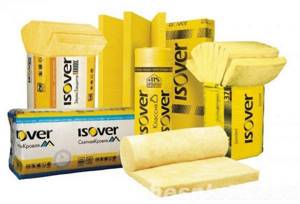
Now on to the topic of this section: can glass wool burn? The material belongs to the NG class, does not ignite and does not support combustion, and sinteres at +500–+550°C. But the upper temperature limit recommended by different manufacturers is in the range of 250-450°C. It is determined by its resistance to destruction of organic binding components.
Extruded polystyrene foam from Ursa
Extruded polystyrene foam from Ursa in beige color.
Extruded polystyrene foam from Ursa is no different in characteristics from its competitors. Extrusion is the process of foaming polystyrene foam with carbon dioxide. As a result, the amount of air in the material increases, the resistance to heat transfer increases, and the weight decreases. Specifications:
- thermal conductivity lambda 0.032 W/m*C;
- the material burns, it cannot be heated above 75 degrees;
- does not conduct steam, the coefficient is only 0.004 mg/m*h*Pa;
- does not absorb water, no more than 0.3% per day.
Material thickness from 30 to 100 mm. Slab dimensions 600x1250 mm. Installation is made easier by a stepped groove on the edge. Thanks to it, the plates are more rigidly fastened to each other and an additional barrier to air is created. Ursa extruded insulation, according to reviews, is used only for thermal insulation of blind areas, basement walls and foundations. It is also suitable for insulating the ground.
With equal density of Ursa insulation and conventional foam, extruded polystyrene foam will better protect against heat loss.
This is due to the high cost of the material, although, from a technical point of view, it can be used for walls, floors, roofs and attic floors. The only prohibition on use is associated with wooden houses made of timber and logs. Due to the low vapor conductivity of Ursa insulation, its use is only possible for brick or concrete walls.
Summing up, we can conclude that the manufacturer Ursa pays special attention to mineral wool production technology. Mineral wool slabs and rolls are made from quartz sand. Thermal insulation has many certificates confirming the high degree of environmental friendliness of the material. Regarding extruded polystyrene foam, it does not have any outstanding characteristics, but the quality of the insulation is very high, which is ensured by the introduction of new developments in the production process.
“If it’s a car, then it’s Mercedes, if it’s insulation, then it’s Ursa (URSA)” - and this statement really holds true. Founded in 2002, the Spanish-German brand has proven to everyone who is boss.
According to the Global Research & Data Services “Insulation” study, in 2010 the company was the Russian market leader in the manufacture of fiberglass products.
It’s enough to go to any hardware store and our hero will definitely be among the famous manufacturers. Why is URSA mineral wool so good? The technical specifications will show a clear answer to this question.
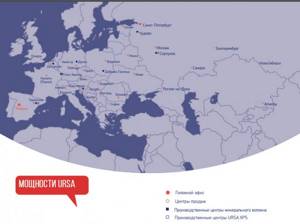
Application area
Mineral wool insulation is produced on the basis of fiberglass using new and innovative technologies. This made it possible to minimize the characteristic disadvantages of glass wool. The company also produces special membrane coatings to create effective thermal insulation systems.
This insulation is widely used in the construction industry because it is universal. Most often it is used for the device:
- flat and pitched roofs;
- internal and external walls;
- interfloor ceilings;
- foundations;
- partitions;
- floor structures;
- highways;
- heating pipes;
- railway embankments;
- baths and saunas;:
- loggias and balconies;
- runways.
Installation of insulation can be performed not only by experienced builders. This can be done by people with no experience in construction.
During the work process, it is important to follow the basic rules and then the installation will be done efficiently and effectively.
Product line
Few people know that in fact the URSA concern is part of the URALITA company (Uralit), which has 4 main areas of activity:
- Pipelines;
- Thermal insulation;
- Plaster;
- Roofing materials.
The URSA brand represents the second group - thermal insulation materials. The company’s marketers did not torment customers with a huge line, but divided all products into 5 main groups:
- GEO;
- PUREONE;
- TERRE;
- XPS;
- SECO.
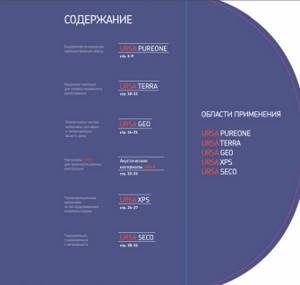
The last two are extruded polystyrene foam products and insulating membranes. In today's article we are talking about URSA glass wool, so we will focus on the first three points. Ursa insulation, both in rolls and in slabs, is made of fiberglass.
Pure One - when you need perfection
URSA mineral wool reveals its full power in the URSA PURE ONE line. The company focuses on the ultra-high quality of such insulation materials. Of the 3 products in the line, 2 are rolls and one is slabs. You already know how to distinguish markings. The manufacturer insists on environmentally friendly products. It is stated that mineral wool does not chip and does not leave dust. Made from 95% renewable fibres. Does not contain formaldehyde, which is released in small quantities during operation and in large quantities during melting. Below are the purposes of each product.
Main characteristics of the URSA PURE ONE line:
| Name | Purpose | Form factor | Predominant construction area |
| ursa pureone34PN | One of the most environmentally friendly products in the line. Plates with a hardness of 18 kg/m3. | Plates | Professional/private |
| ursa pureone37RN | In general, materials in this series are recommended for cases where increased environmental friendliness is needed, for example, insulation of kindergartens and rooms. | Mats (rolls) | |
| URSA PURE ONE 35QN | In general, similar to the previous one. | Professional |
International expansion
1996 - international expansion
Poliglas is building a second plant for the production of extruded polystyrene (XPS) in Kweis (Germany). Soon after this, construction of another plant in Bondeno (Italy) begins.
1996 - receipt of the first international certificates
Poliglas receives the first environmental product declarations, FDES (Fiches de Données Environnementales et Sanitaires) from the French regulatory authorities.
2004 - birth of URSA
As a result of the merger of Poliglas and Pfleiderer (a German thermal insulation company), a new company appears that combines the experience of both companies - the URSA company.
2007 - consolidation of international expansion
URSA is building new XPS plants in Russia and France, significantly increasing its production capacity.

